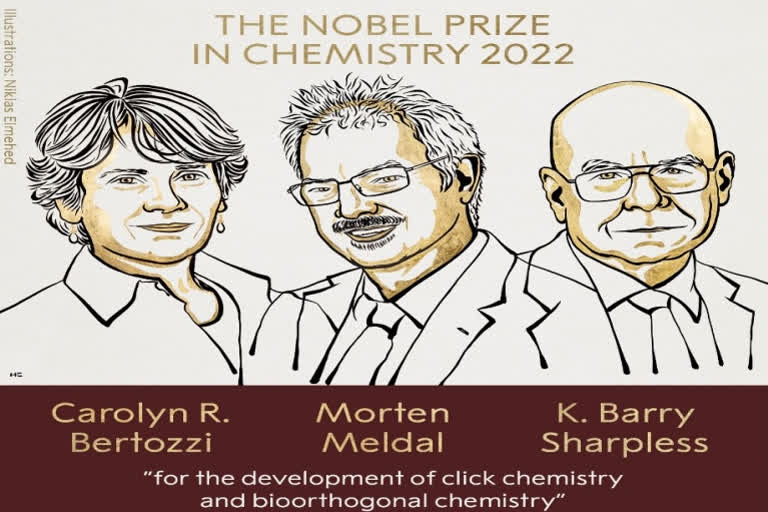Stockholm: The 2022 Nobel prize in Chemistry was jointly awarded to Carolyn Bertozzi (Stanford University, USA), Morten Meldel (University of Copenhagen, Denmark), and K. Barry Sharpless (Scripps Research, USA) for their development of click chemistry and bioorthogonal chemistry. Hans Ellegren, Secretary General, Royal Swedish Academy of Sciences, announced the winner Wednesday at the Karolinska Institute in Stockholm.
Sharpless and Meldal have laid the foundation for a functional form of chemistry – click chemistry – in which molecular building blocks snap together quickly and efficiently. Bertozzi has taken click chemistry to a new dimension and started utilising it in living organisms.
The 2022 Nobel Peace Prize will be announced on Friday and the economics award on October 10. The prizes carry a cash award of 10 million Swedish kronor (nearly USD 900,000) and will be handed out on Dec. 10. The money comes from a bequest left by the prize's creator, Swedish inventor Alfred Nobel, who died in 1895.
Did you know?
- 114 Nobel Prizes in Chemistry have been awarded between 1901 and 2022.
- 25 chemistry prizes have been shared by two laureates.
- 8 women have been awarded the chemistry prize so far.
- 2 people, Frederick Sanger and Barry Sharpless, have been awarded the chemistry prize twice.
- 35 years was the age of the youngest chemistry laureate ever, Frédéric Joliot, who was awarded the Nobel Prize in 1935.
- 97 was the age of the oldest chemistry laureate, and oldest laureate ever, John B. Goodenough.
It just says click – and the molecules are coupled together
Chemists have long been driven by the desire to build increasingly complicated molecules. In pharmaceutical research, this has often involved artificially recreating natural molecules with medicinal properties. This has led to many admirable molecular constructions, but these are generally time consuming and very expensive to produce.
“This year’s Prize in Chemistry deals with not overcomplicating matters, instead working with what is easy and simple. Functional molecules can be built even by taking a straightforward route,” says Johan Åqvist, Chair of the Nobel Committee for Chemistry.
Barry Sharpless – who is now being awarded his second Nobel Prize in Chemistry – started the ball rolling. Around the year 2000, he coined the concept of click chemistry, which is a form of simple and reliable chemistry, where reactions occur quickly and unwanted by-products are avoided.
Shortly afterwards, Morten Meldal and Barry Sharpless – independently of each other – presented what is now the crown jewel of click chemistry: the copper catalysed azide-alkyne cycloaddition. This is an elegant and efficient chemical reaction that is now in widespread use. Among many other uses, it is utilised in the development of pharmaceuticals, for mapping DNA and creating materials that are more fit for purpose.
Carolyn Bertozzi took click chemistry to a new level. To map important but elusive biomolecules on the surface of cells – glycans – she developed click reactions that work inside living organisms. Her bioorthogonal reactions take place without disrupting the normal chemistry of the cell. These reactions are now used globally to explore cells and track biological processes. Using bioorthogonal reactions, researchers have improved the targeting of cancer pharmaceuticals, which are now being tested in clinical trials.
Click chemistry and bioorthogonal reactions have taken chemistry into the era of functionalism. This is bringing the greatest benefit to humankind.



